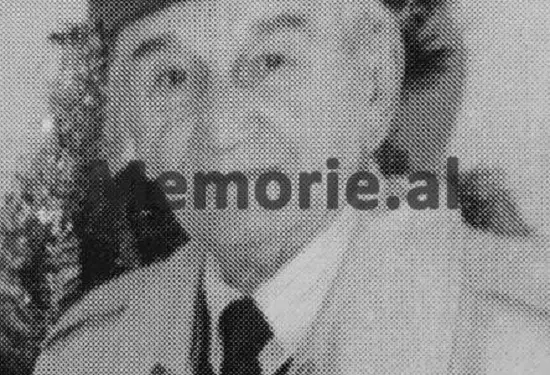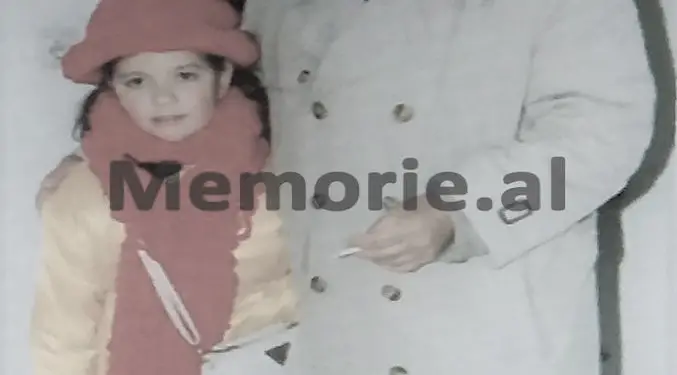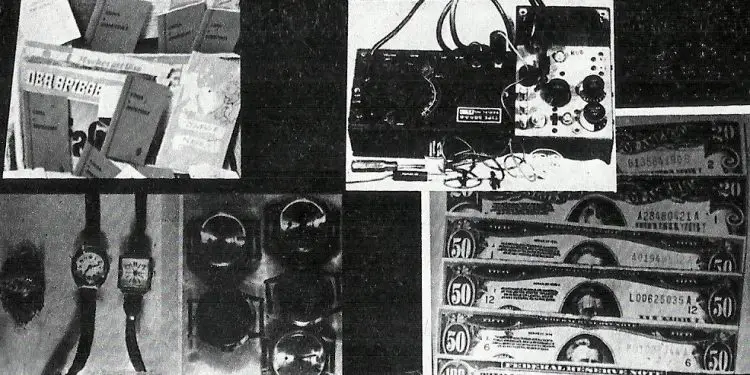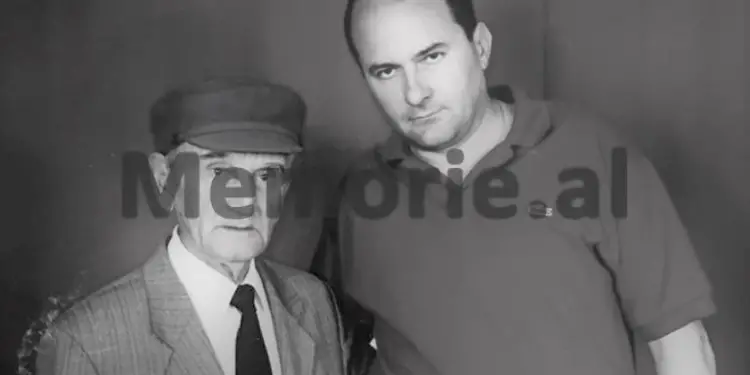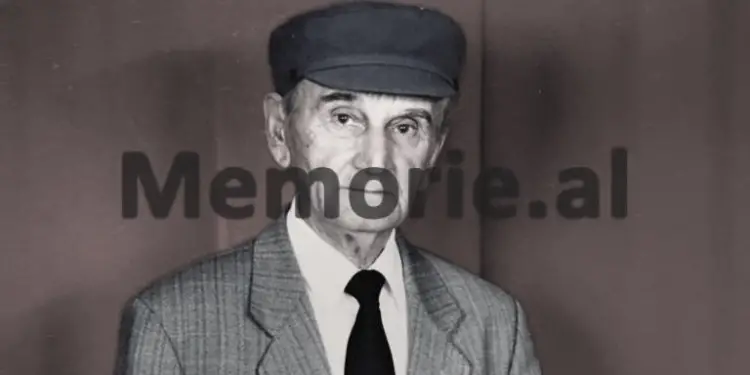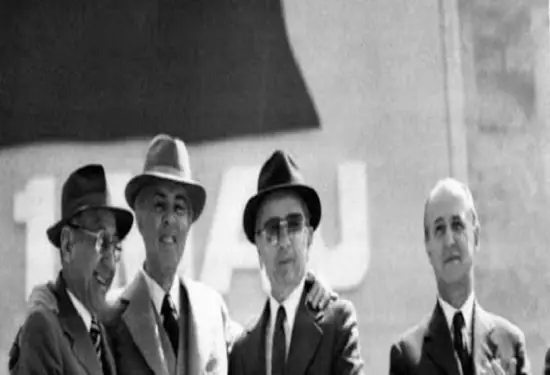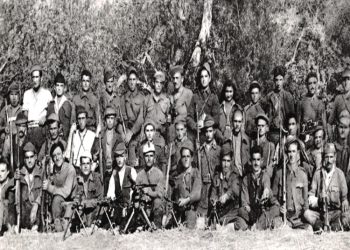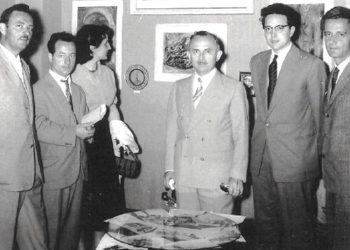Dashnor Kaloçi
Memorie.al publishes the unknown and rare story of Avdul Hakan Banushi from the village of Golem in Gjirokastra, who during the occupation of the country (1939-1944), unlike his entire family who joined the forces partisan, he joined the ranks of the nationalist youth organization “Balli Kombëtar” in the city of Durrës, where he was arrested by German forces in October 1943 and together with 73 other people, were initially sent to the German Camp of Pristina, and then in the mass extermination camps in Landesberger and Daku, from where he could only be released in 1945, after the intervention of Anglo-American forces. Banushi returned to Albania in 1945, after staying for some time in the Reggio-Emilia camp in Italy (where at that time were also some of the main leaders of Balli and Legality headed by Mit’hat Frashëri and Abaz Kupin) and his arrest , a few days after arriving home, after at the Lapraka airport, the partisan guards found a letter given to him by the former Prefect of Gjirokastra, Rasim Babameto, while they were in Reggio-Emilia. Banush was sentenced to 18 years in prison on charges of being an “agent of the Anglo-Americans” and released in 1961, where he did not spend much time with his family in the village of Golem, after being arrested again while interned in the town. of Fier, from where he managed to escape from prison, from the first night and fled in the direction of Gjirokastra, where he crossed the state border and crossed into Greece, where he soon gained political asylum in the United States. Banushi’s engagement in the ranks of the Albanian political diaspora in the West, as a member of the “Free Albania Committee”, where in 1973, after being trained by the CIA, he came several times with secret missions to Albania, in order to carry out assassinations Enver Hoxha, in the big parade of November 29, 1974, on the occasion of the 30th anniversary of the liberation and his arrest in 1975, near the border of Hani i Hotit, after a trap set by the Minister of Internal Affairs himself, Kadri Hazbiu, from where he would then be isolated for two years in the cells of ‘Ward 313’, in Tirana Prison and then in Burrel, from where he could only be released at the beginning of 1991.
“When Albania’s first contradictions with the People’s Republic of China began in 1972-’73, it added even more to our confidence that the time had come to organize concrete measures for a possible landing in Albania. After the previous talks between the leaders of the “Free Albania” Committee with Mr. Joseph Shisko, Deputy Secretary of State and Major Thomas Smith covering the Albanian political emigration to the USA, in January 1974, the Presidency of the Organization The “Albanian Anti-Communist Resistance Front” decided to send to Albania the first group, which would consist of five people. Among the main tasks that the group would perform were: ‘Meetings with people dissatisfied with the communist regime, the demolition of the Stalin and Lenin monument in the center of Tirana, the blowing up of the headquarters of the Central Committee of the ALP, the distribution of anti-communist propaganda materials that had been prepared before in New York, etc. It was decided that the first group would be led by me, as I was acquainted with the contingent of families persecuted by the communist regime, where we would initially rely. Apart from me, this group also included I. Rrushiti, N. Banushi, I. Lame and A. Sula. After some intensive preparations we made on a secret basis, we finally set off on the plane that would traverse the itinerary: New York – London, – Amsterdam – Rome – Athens. When we arrived in the Greek capital, we took refuge in the Hotel “Atlantik” and the next day we went to the military base of Preveza, where the colonel who was waiting for us supplied us with weapons consisting of five automatic weapons, five pistols, 20 grenades, 6 kg. Dynamite, capsules and mechanical devices for their detonation, swimming tools and clothing, a radio receiver and transmitter, as well as many other ammunition and equipment. After arranging these in a safe place, I talked to the colonel about the possible routes we had to follow to enter Albania and at seven o’clock in the evening we set off in a small speedboat run by three sailors and after a few hours we arrived in the coast of Ksamil ”.
This is how he remembered the beginning of the “Albanian adventure”, Avdul Hakan Banushi, originally from Golem of Gjirokastra, who recounted for the first time some of the most sensational events of his life, which occurred in 1974 – ’75, when he at the head of a commando group launched by the United States of America, he entered Albania several times with secret missions.
Who is Avdul Banushi and what is his past? Why was he interned in the Nazi concentration camp in Dhaka, Germany, and how was he released? How did he return to Albania in October 1945 and why was he sentenced to 18 years in prison, being accused of being an agent of the Anglo-Americans? How did he manage to escape from the Fier Branch of Internal Affairs in the first days of August 1961 and how did he cross the border into Greece? What was asked of him in Athens and how did he gain political asylum in the United States? Who were the Albanian anti-communist leaders who organized the “Throne of Resistance” and why did the “Albanian adventure” of Abdyl Banushi and the assassination of Enver Hoxha in the big parade of the 30th anniversary of the liberation on November 29, 1974 fail? Who was the man who accompanied and betrayed Abdyll Banushi on his last mission in Albania, which caused him to fall alive into the hands of the Albanian border forces near Hani i Hotit, after which he will was he isolated in the horrific Burrell prison, until the fall of the communist regime in 1991? Regarding these and many other events and facts, we know the exclusive interview given to us by Mr. Banushi, a few years ago, which will be in six numbers in a row, starting today.
Mr. Banushi, what happened to you after your release from the first prison?
After serving 15 years in the Vloçisht, Maliq Swamp and Burrel prisons, I was released on February 10, 1961 and went to my family in the village of Golem in Gjirokastra, where some police officers came from Gjirokastra Branch of Internal Affairs, who told me that I had to go with them, after I was given the measure of internment, with the motivation: “Unrehabilitable”. According to the order given, they took me and took me to the city of Fier, where I was accompanied only by Sejfulla Malëshova. A few days later, on August 8 of the same year, while I was walking with Sejfulla, I was arrested again and isolated in one of the cells of the Internal Branch of Fier, without communicating to me what I had been arrested for. That night when I had not yet been questioned, I was able to cut the turrets with a small saw that could not be found in my pocket during a search by a police officer. After coming down from the window, I went out of the main gate of the Branch, ostensibly as its worker, wishing the policeman good night. After my escape and after receiving some documents of 16,000 All (old) that I had saved, I left by car in the direction of Berat and from there with another truck to Gjirokastra. That same night I crossed Mount Bureto and fled to Greece.
How could you cross the border and where did you go after crossing Greek land?
To go to the state border with Greece, I crossed the mountains and with great difficulty I came to the Greek land, without being noticed by our soldiers, who passed me very close with the whole border dog. There I went in the direction of a church, where a little later some Greek soldiers came and picked me up, who were apparently notified by the priests who served there. I was taken to Ioannina in a closed military vehicle, where I underwent investigative procedures for four months. On December 12, 1961, I was taken from Athens to Athens, where, as a rule, all anti-communist immigrants had to be questioned by the offices of the Greek CIA and KIP.
What were you asked about in these offices?
In addition to the usual formalities, they asked me about my political convictions, about the Burrel prisoners where I had served my sentence, the Ministry of Justice, about Enver Hoxha, and about Tomorr Xhafer Ypi, who had been Albania’s trade attaché during the war in Greece. , about whom they spoke quite sympathetically that he had helped the Greek people with food.
What did they tell you about Enver Hoxha?
The American officer told me that: Enver Hoxha was ungrateful to the Americans, because he had turned his back on them, at a time when they had helped him during the war.
Mr. Avdul, how could you leave Greece for the USA?
On December 10, 1961, I was taken from Athens, where I was interrogated, to the Llavros camp, where many political immigrants from various Eastern European countries were staying. There was a special commission that dealt with their coordination and through that commission; I gained the right to go to the US as a political asylum seeker. After that, on December 11, 1961, we set sail from the Port of Patras, and on May 31, 1962, we arrived in New York.
What did you first deal with in the US?
Through some of my Albanian friends that I had previously called from Greece, I settled into work as a waiter and then with the help of Professor Stavro Skënd, I finished school at “Robert College”.
Did you get involved in the political parties of the anti-communist diaspora operating in the US?
Since I went to the US, I saw that the Albanian anti-communist diaspora was very divided and there were three parties of the ‘National Front’, three of the ‘Legality’ and one of the ‘Independent Bloc’. Although I had many offers from their leaders to join those parties, at first I stayed somewhat sidelined from them.
Did you follow the political developments that took place in the world and in Albania?
Certainly, the political developments in the world and in Albania were followed with great interest by the entire Albanian political diaspora. In January 1971, when the US-China talks began in Warsaw, we received them with great interest. This interest was greatly increased due to the fact that the Albanian government did not receive the news well and was very worried about what was happening with China, which had the only friendly country on which it relied. After that, the first contradictions started between Albania and China, which at that time seemed to be of interest to the Americans as well.
Where did the Albanian political diaspora see the concrete interest in the American-Chinese talks?
When those talks started, it was more than natural that there could not have been a review of American policy towards Albania as well; therefore the Albanian political diaspora followed those developments with great interest.
Where did the review of American policy towards Albania really consist, after the first contradictions of official Tirana with Beijing?
The first step taken by the US government was to dissolve the “Free Albania” Committee. Many of us misunderstood this move, but it was a smart move by the US to improve Washington’s relations with official Tirana. But Enver Hoxha was very stubborn and not only did he not intend to improve relations with the United States, but on the contrary, he became angry with China, which was approaching America. As a result of this stance taken by official Tirana, the Americans countered by recognizing the “Free Albania” Committee and funding it. After that, there was a renewal of all the organizations that made up that Committee and the American government, recognizing him as the only representative of anti-communist immigration in the Western World, supported him and politically.
After the re-recognition of the “Free Albania” Committee, what steps did it take?
With the re-recognition of the Committee, its former Chairman Dr. Rexhep Krasniqi, Prof. Vasil Gërmenji, former vice-chairman of the Committee “Captive Europe” and some others, decided to create the organization “Albanian Anti-Communist Resistance Front”, which of course would be illegal. After this decision, contacts were made (by phone and fax) with some groups of Albanian anti-communist immigrants in the USA, France, Brussels, Rome, etc., who agreed to join there and started setting up commissions.
Why would this organization be created illegally?
The organization was illegal, because in order to be legal, the necessary permission had to be obtained based on the program you submitted. To make it legal, Prof. Vasil Gërmenji went to Washington and met with the Deputy Secretary of State for the Balkans, Mr. Joseph Shisko, to whom he laid out the plan of the organization. Mr. Shisko told Gërmenji that: for now no action should be taken. The meeting was also attended by Major Thomas Smith, in charge of Albanian anti-communist emigration, who knew the Albanian language quite well and spoke it in the Shkodra dialect. He had lived for several years in Albania, after his father had served as Consul in Shkodra, in the time of Zog. Mr. Smith told Vasili that the organization they had created had no political platform and was a terrorist organization. And as such, it could not even be accepted as a political party because it was the Front, since there were four other parties inside.
But after the refusal to recognize the “Resistance Front”, how did its leaders act?
Although the US authorities refused to recognize the “Resistance Front”, it continued its activities illegally. The first step was to organize a meeting of the five Albanian parties in Madrid, Spain in 1972. This was taken over by Leka Zogu, who intervened with his school friend, Crown Prince Juan Carlos, to talk to General Franco. . In the second meeting that Leka Zogu had with Prince Juan Carlos, he asked him how many Albanian emigrants were outside Albania, Leka replied that from 1944 until then, there should have been 15,000 refugees throughout the West. . After that, Lekë was given the right to hold a meeting in Madrid in August 1972, with all the leaders of the Albanian political parties in the West.
Who attended that meeting and what do you know about it?
As far as I remember this meeting was held in July 1972, the National Front Party was represented by Prof. Vasil Gërmenjin, Hasan Dosti of the Party ‘Balli Kombëtar Agrar’, sent his deputy Petraq Ktona, ‘Legality’, sent Fuat Myftinë, ‘Blloku Indipendent’, Ismail Vërlac and Ndue Pjetër Gjomarkaj, ‘Balli Kombëtar’ of Ali Këlcyra sent the lawyer Halim Begeja, while the Ball Party of Abaz Ermenji, it seems to me that was represented by Ermenji himself. It discussed the possibility of uniting these parties on a common front and establishing a democratic government in exile. This government would be of the Western type and would lead all actions to overthrow the communist government of Enver Hoxha. From what Prof. had told me. Vasil Gërmenji, during the meeting, someone proposed that Leka Zogu be put in charge of the armed forces that would land in Albania, since he had graduated from military schools. However, this proposal was opposed by one of the ballistic exponents and in the end the meeting failed. The whole problem of the Albanian anti-communist leaders that brought about the division between them was who would take the “wheel” of the United Front when Enver Hoxha was overthrown.
What happened after that meeting failed, there were attempts to reunite?
At the end of the meeting in Madrid, Vasil Gërmenji proposed that negotiations be held again to reach an agreement and that the meeting take place at the headquarters of the Committee “Free Albania” (Manhattan, 34 Leksiton Aveny, New York) where we had four offices, which had been inherited since 1949, by Mit’hat Frashëri. In that meeting chaired by Vasil Gërmenji, Stavro Skëndi, Rakip Frashëri, Dr. Hamdi Uruçi, Athanas Gega, etc., I also participated. It announced the creation of the organization “Albanian Anti-Communist Resistance Front” and it was decided to hold a large gathering where all those who were ready to fight for the overthrow of the communist dictatorship of Enver Hoxha. After that in September 1973, another much more extended meeting was held, where at the proposal of Dr. Rexhep Krasniqi, chairman of the “Resistance Front” was elected Vasi Gërmenji, while his deputy, Stavro Skëndi. As their advisor, Krasniqi proposed himself and Rakip Frashëri, while he proposed me as the organizational secretary of that organization. After our election, nine local organizational secretaries were elected, residing in various US states, where many Albanians lived and worked. Two other secretaries would be in Canada and seven others in different European countries, where there were many Albanian political emigrants.
Who was Avdul Hakan Banushi?
Abdul Banushi was born in 1927 in the village of Golem in the province of Kurvelesh in Gjirokastra. After finishing primary school in his native village, Avdyli attended classes in the gymnasium of the city of Durrës. While during the period of occupation (1939-1944), his whole family joined the Anti-Fascist Movement and his father, Hakan, joined the partisan ranks in the 5th Assault Brigade, Avduli joined the ranks of the organization nationalist of the “National Front” in the city of Durres. Being one of the main exponents of the Youth of the National Front in that city, during 1943 he participated in several anti-fascist demonstrations organized by the nationalist youth of the Durrës district. On November 23, 1943, he was arrested by the Germans and the reason for that was the Italian SIM documents (where he appeared as an active participant in several demonstrations), which after the capitulation of Italy, fell into the hands of German forces who immediately took control of all the towns and offices where the Italian military forces had been. From the city of Durrës where he was initially isolated by German forces, together with 73 other people from the same city, they were sent to the Tirana prison. After some time, together with a large group of prisoners, Avdul Banushi was sent to the German camp of Prishtina in Kosovo and from there they were transferred to the Landesberger prison, which was located in a medieval castle in the province of Bavaria, where years ago Adolf Hitler himself had served his sentence for three years in a row. In that prison, where there were many other Albanians, Avdul Banushi remained until October 1944, when he was transferred back to the Dakau camp, where he worked on digging trenches that the Germans began to build to protect themselves. from Anglo-American allied force tanks approaching the camp in those days. On April 14, 1945, Avdul Banushi, along with other prisoners of that mass extermination camp, was released with the help of the Anglo-Americans and set out for Italy. After arriving in the Apennine Peninsula, with the help of the Anglo-Americans, Banushi settled in the Reggio Emilia Camp, where at that time there were dozens of other Albanians who had left Albania as political emigrants at the end of November 1944, to escaped the revenge of Enver Hoxha’s communists. After a few days in that camp where most of the main leaders of the nationalist organization “Balli Kombëtar” and those of the “Legality Movement” led by Mit’hat Frashëri and Abaz Kupin were staying, Avdul Banushi was named ‘returned to Albania, according to the request he had made in writing. A few hours before leaving for Albania, the former Prefect of Gjirokastra, Rasim Babameto, as a patriot (fellow citizen) he had, I sent a letter to Avdul, to send to the people of his family living in the “Shallvare” Palaces in Tirana . On October 20, 1945, when Avduli and several other Albanians who had sought repatriation arrived by small plane at the Lapraka military airfield on the outskirts of Tirana, they were subjected to strict control by the guards. partisans who were there as effectives of the structures of the Ministry of Internal Affairs. After seizing the letter of the former Prefect Babameto, the partisan guards released Avdul and he left for his native village, in Golem of Gjirokastra. But while he was not well acquainted with his parents, brothers and sisters, some police officers from Gjirokastra arrived there, who “on behalf of the people” arrested him and brought him in a closed car to the State Security Directorate in Tirana. . After an investigation that lasted about 18 months, Avdul Banushi appeared in court and was sentenced to 18 years in political prison, charged with “hostile activities in collaboration and as an agent of the Anglo-Americans.” The real reason for Banushi’s conviction was his participation with the forces of the nationalist organization “Balli Kombëtar”, while the letter given to him by Rasim Babameto in the Reggio-Emilia camp was found as a pretext. After serving his sentence in the Vloçisht camp and the Maliqi Swamp in the Korça district and most of it in the Burrel prison, Avduli was released on February 10, 1961, after gaining several years of amnesty reductions. After his release from prison, he returned to his home in the village of Golem in Kurvelesh, where he did not spend much free time, after he was taken and interned in the city of Fier, where after a few days (August 8 of that year), they arrested him again and isolated him in one of the dungeons of the Internal Affairs Branch of that city, from where he had managed to escape since the first night. That same night, he left in the direction of Gjirokastra district and from there he crossed the state border, fleeing to Greece. After some time in the Lavrio camp, he was able to gain political asylum status and move to the West. On May 31, 1962, Banushi arrived in the United States, where he settled for work and also pursued higher university studies by graduating with a degree in Mechanical Engineering. During his stay in the United States he joined the ranks of the Albanian political diaspora and in 1974-75, he entered Albania several times illegally with secret missions, which were organized by the Committee “Free Albania”, based in New York. On April 8, 1975, Avdul Banushi was apprehended by State Security forces as he entered the Albanian border near Hani i Hotit. His capture and arrest was made through a trap that was prepared and elaborated in detail by the then former Minister of Internal Affairs, Kadri Hazbiu. Although he was held in solitary confinement for about two years in one of the cells of ‘Ward 313’ (Tirana Prison), placed in a coffin, where he was interrogated by Minister Kadri Hazbiu and Deputy Minister Feçor Shehu, Banushi refused. none of the accusations made against him as an “agent of the Americans” that had been sent to Albania on a secret mission by the CIA. He then went on trial where he was sentenced to 25 years in prison and was sent to Burrell Prison, where he could only be released in 1991, with the last political prisoners leaving the cells of that regime, who was in the last throes. After being released from prison, he returned to the city of Gjirokastra, where he started a family and lived there with his wife and daughter, until he passed away in 2010. /Memorie.al
The next issue follows




